Game Stick With A Net
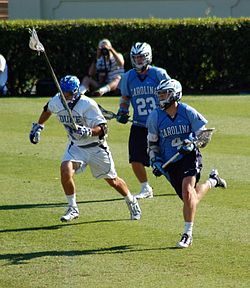 Men'due south field lacrosse game between | |
| Highest governing trunk | World Lacrosse |
|---|---|
| Get-go played | Every bit early as the 17th century |
| Characteristics | |
| Blazon | Team sport, stick sport, ball sport |
| Equipment | Lacrosse stick and ball in addition to various body armor or pads. Different protective gear for different versions of the game |
| Venue | Outdoor lacrosse field or indoor lacrosse rink |
| Presence | |
| Olympic | Men's field at the Summer Olympics in 1904 and 1908. Demonstrated in 1928, 1932 and 1948 |
| World Games | Women's field in 2017 |
Lacrosse is a team sport played with a lacrosse stick and a lacrosse brawl. Information technology is the oldest organized sport in Northward America,[1] with its origins with the indigenous people of N America as early equally the twelfth century.[ii] [3] [4] The game was extensively modified past European colonists, reducing the violence, to create its current collegiate and professional class.[5]
Players employ the head of the lacrosse stick to carry, pass, catch, and shoot the ball into the goal. The sport has four versions that have unlike sticks, fields, rules and equipment: field lacrosse, women's lacrosse, box lacrosse and intercrosse. The men'south games, field lacrosse (outdoor) and box lacrosse (indoor), are contact sports and all players wear protective gear: helmet, gloves, shoulder pads, and elbow pads.[6] The women's game is played outdoors and does non allow body contact but does allow stick to stick contact.[7] The only protective gear required for women players is eyegear, while goalies wear helmets and protective pads. Intercrosse is a mixed-gender non-contact sport played indoors that uses an all-plastic stick and a softer ball.[8]
The modernistic sport is governed by World Lacrosse and is the just international sport organization to recognize First Nations bands and Native American tribes equally sovereign nations.[9] The organisation hosts the World Lacrosse Championship for men, the Women'due south Lacrosse World Cup, the World Indoor Lacrosse Championship for box lacrosse, and the Under-19 World Lacrosse Championships for both men and women.[10] Each is held every 4 years.[ten] Lacrosse at the Summer Olympics has been contested at ii editions of the Summer Olympic Games, 1904 and 1908.[xi] [12] [13] It was also held every bit a sit-in event at the 1928, 1932, and 1948 Summer Olympics.[14] [15]
History
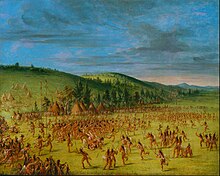
Brawl-play of the Choctaw – ball up by George Catlin, c. 1846–1850
Lacrosse is based on games played by various Native American communities as early equally 1100 AD.[16] By the 17th century, a version of lacrosse was well-established and was documented past Jesuit missionary priests in the territory of nowadays-day Canada.[17]
In the traditional aboriginal Canadian version, each squad consisted of about 100 to 1,000 men on a field several miles (several kilometers) long. These games lasted from sunup to sundown for two to three days straight and were played equally part of ceremonial ritual, a kind of symbolic warfare, or to requite cheers to the Creator or Primary.[18]
Lacrosse played a significant office in the customs and religious life of tribes across the continent for many years. Early lacrosse was characterized by deep spiritual involvement, befitting the spirit of gainsay in which it was undertaken. Those who took role did then in the role of warriors, with the goal of bringing glory and honour to themselves and their tribes.[19] The game was said to be played "for the Creator" or was referred to equally "The Creator's Game".[20]

Ball Players by George Catlin
The French Jesuit missionary Jean de Brébeuf saw Huron tribesmen play the game during 1637 in present-day Ontario. He called information technology la crosse , "the stick" in French.[21] The proper name seems to be originated from the French term for field hockey, le jeu de la crosse .[22]
James Smith described in some detail a game being played in 1757 past Mohawk people "wherein at present they used a wooden ball, about 3 inches (7.6 cm) in diameter, and the instrument they moved it with was a strong staff about 5 feet (ane.5 g) long, with a hoop internet on the cease of it, big enough to contain the ball."[23]
Anglophones from Montreal noticed the game beingness played past Mohawk people and started playing themselves in the 1830s.[21] In 1856, William George Beers, a Canadian dentist, founded the Montreal Lacrosse Order.[24] In 1860, Beers codified the game, shortening the length of each game and reducing the number of players to 12 per team. The commencement game played under Beers'southward rules was at Upper Canada College in 1867; they lost to the Toronto Cricket Gild past a score of 3–i.[21]
The new sport proved to be very pop and spread across the English-speaking world; past 1900 there were dozens of men's clubs in Canada, the United States, England, Australia, and New Zealand. The women'due south game was introduced past Louisa Lumsden in Scotland in 1890. The beginning women's social club in the United States was started past Rosabelle Sinclair at Bryn Mawr School in 1926.[25]
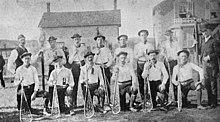
In the Us, lacrosse during the belatedly 1800s and first half of the 1900s was primarily a regional sport centered effectually the Mid-Atlantic states, especially New York and Maryland. Nevertheless, in the concluding half of the 20th century, the sport spread outside this region, and can exist currently found in most of the United states of america. According to a survey conducted by US Lacrosse in 2016, at that place are over 825,000 lacrosse participants nationwide and lacrosse is the fastest-growing team sport amongst NFHS member schools.[26]
Versions of lacrosse
Field lacrosse
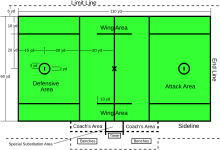
Diagram of a men's higher lacrosse field
Field lacrosse is the men'due south outdoor version of the sport. There are x players on each team: 3 attackmen, three midfielders, three defensemen, and one goalie. Each thespian carries a lacrosse stick. A short stick measures between twoscore and 42 inches (100 and 110 cm) long and is used by attackmen and midfielders. A maximum of four players on the field per team may behave a long stick which is between 52 and 72 inches (130 and 180 cm) long and is used by the iii defensemen and sometimes one defensive midfielder. The goalie uses a stick with a caput as wide as 12 inches (30 cm) that can be between 40 and 72 inches (100 and 180 cm) long.[27]
The field of play is 110 by lx yards (101 past 55 m). The goals are 6 by 6 ft (1.eight past 1.8 m) and are 80 yd (73 m) apart. Each goal sits inside a circular "pucker", measuring eighteen ft (5.5 thousand) in diameter.[28] The goalie has special privileges within the pucker to avert opponents' stick checks. Offensive players or their sticks may not enter into the pucker at any time. The mid-field line separates the field into an offensive and defensive zone for each team. Each team must go on four players in its defensive zone and three players in its offensive zone at all times. Information technology does not thing which positional players satisfy the requirement, although commonly the iii attackmen stay in the offensive zone, the three defensemen and the goalie stay in the defensive zone, and the iii middies play in both zones. A team that violates this rule is offsides and either loses possession of the ball if they have it or incurs a technical foul if they do not.[29]

The regulation playing time of a game is sixty minutes, divided into iv periods of xv minutes each.[29] Play is started at the beginning of each quarter and after each goal with a face-off. During a confront-off, 2 players lay their sticks on the ground parallel to the mid-line, the two heads of their sticks on opposite sides of the brawl. At the whistle, the face-off-men fleck for the ball, oft by "clamping" it under their stick and flicking it out to their teammates. When one of the teams has possession of the ball, they bring it into their offensive zone and try to score a goal. Due to the offsides rule, settled play involves six offensive players versus 6 defensive players and a goalie.[thirty]
If the ball goes out of bounds, possession is awarded against the team that touched it last. The exception is when the ball is shot towards the goal. Missed shots that exit of bounds are awarded to the team that has the role player who is the closest to the ball when and where the ball goes out. During play, teams may substitute players in and out if they leave and enter the field through the substitution area, sometimes referred to as "on the fly". After penalties and goals, players may freely substitute and practice not have to go through the substitution area.[31]
Penalties are awarded for rule violations and issue in the offending team losing possession (loss of possession) or temporarily losing a histrion (time serving). During time serving penalties, the penalized team plays with one fewer player for the duration of the punishment. Time serving penalties are either releasable or non-releasable. When serving a releasable penalty, the offending player may re-enter play if a goal is scored by the opposing team during the elapsing of the penalty. Non-releasable penalties do non permit this and the player must serve the entire duration. In conjunction with the offsides rule, the opponent may play with half-dozen attackers versus the penalized team's v defenders and goalie. The team that has taken the penalization is said to be playing man downwards, while the other team is man upwardly. Teams will use diverse lacrosse strategies to attack and defend while a role player is existence penalized.[29]
At that place are two classes of rule violations that consequence in penalties: technical fouls and personal fouls. Technical fouls, such as offsides, pushing, and property, event in either a loss of possession or a xxx-second penalty, depending on which team has the ball. Personal fouls, such every bit cross-checking, illegal body checking, or slashing, business organization actions that endanger player safe. Cantankerous-checking is when a player strikes another player with the shaft of the stick between his hands. A slash is when a player strikes another actor with the terminate of the stick anywhere besides the gloves. These fouls depict i-minute or longer penalties; the offending player must leave the field.[29]
Box lacrosse

A game of box lacrosse in the NLL
Box lacrosse is played by teams of v runners plus a goalie on an ice hockey rink where the water ice has been removed or covered by bogus turf, or in an indoor soccer field. The enclosed playing area is called a box, in contrast to the open playing field of the traditional game.[32] This version of the game was introduced in Canada in the 1930s to promote business organization for hockey arenas outside of the ice hockey season.[33] : 157 Within several years information technology had nearly supplanted field lacrosse in Canada.[33] : 120
The goals in box lacrosse are smaller than field lacrosse, traditionally 4 ft (1.two m) wide and alpine. Also, the goaltender wears much more protective padding, including a massive chest protector and armguard combination known as "uppers", large shin guards known every bit leg pads (both of which must follow strict measurement guidelines), and ice hockey-style goalie masks.[32] [34]
The style of the game is quick, accelerated by the close confines of the floor and a shot clock. The shot clock requires the attacking team to accept a shot on goal within 30 seconds of gaining possession of the brawl.[32] Box lacrosse is as well a much more than concrete game. Since cross checking is legal in box lacrosse, players vesture rib pads and the shoulder and elbow pads are bigger and stronger than what field lacrosse players wear. Box lacrosse players wear a hockey helmet with a box lacrosse muzzle. There is no offsides in box lacrosse, the players substitute freely from their bench areas every bit in hockey. However, virtually players specialize in criminal offence or defense, so commonly all five runners substitute for teammates equally their team transitions betwixt offense and defence.[35]
For penalties, the offending role player is sent to the punishment box and his team has to play without him, or man-down, for the length of the penalty. Nigh fouls are minor penalties and last for 2 minutes, major penalties for serious offenses last five minutes. What separates box lacrosse (and ice hockey) from other sports is that at the meridian levels of professional person and junior lacrosse, participating in a fight does not automatically cause an ejection, merely a five-minute major penalty is given.[32]
Box lacrosse is played at the highest level in the National Lacrosse League and by the Senior A divisions of the Canadian Lacrosse Association. The National Lacrosse League (NLL) employs some minor rule changes from the Canadian Lacrosse Association (CLA) rules. Notably, the goals are 4 feet 9 inches (1.45 1000) wide instead of 4 feet (ane.2 m) and the games are played during the winter.[32] [36] The NLL games consist of four fifteen-minute quarters compared with three periods of twenty minutes each in CLA games. NLL players may only apply sticks with hollow shafts, while CLA permits solid wooden sticks.[36] [37]
Women'due south lacrosse
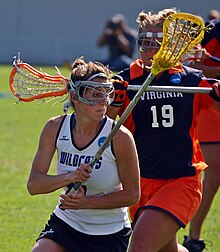
The rules of women's lacrosse differ significantly from men's lacrosse, most notably by equipment and the degree of allowable concrete contact.[38] Women'due south lacrosse rules also differ significantly betwixt the United states of america and all other countries, who play by the Federation of International Lacrosse (FIL) rules. Women's lacrosse does not allow physical contact, the simply protective equipment worn is a mouth guard and center-guard. In the early part of the 21st century, in that location have been discussions of requiring headgear to prevent concussions. In 2008, Florida was the first country to mandate headgear in women's lacrosse.[39] Stick checking is permitted in the women's game, but simply in certain levels of play and within strict rules. Women's lacrosse also does not allow players to have a pocket, or loose cyberspace, on the lacrosse stick. Women beginning the game with a "describe" instead of a confront-off. The two players stand up and the ball is placed between their stick heads while their sticks are horizontal at waist-pinnacle. At the whistle, the players elevator their sticks into the air, trying to control where the brawl goes.[40]
The first modern women's lacrosse game was held at St Leonards School in Scotland in 1890. Information technology was introduced by the school'south headmistress Louisa Lumsden after a visit to Quebec, where she saw it played.[41] The start women'due south lacrosse team in the United states of america was established at Bryn Mawr School in Baltimore, Maryland in 1926.[42]

Women's lacrosse field diagram
Both the number of players and the lines on the field differ from men's lacrosse. In that location are 12 players in women'southward lacrosse and players must abide by certain boundaries that do not exist in men'due south play. The three specific boundaries are the 8-meter (26 ft three in) "fan" in forepart of the goal (eleven chiliad [36 ft 1 in] internationally), the 12-meter (39 ft 4 in) (eight m [26 ft 3 in] internationally) half circle that surrounds the eight-meter fan, and the draw circumvolve in the eye of the field, which is used for draws to start quarters and after goals. The goal circle is also positioned slightly closer to the end line in women'southward lacrosse compared to men'south. In women'southward lacrosse on either the offensive or defensive terminate, the players as well the goaltender are non able to stride within the goal circle; this becomes a "goal-circle violation". However, at the women'southward collegiate level, a new dominion has been established that allows defenders to pass through the goal circumvolve.[43]
The eight-meter fan that is in front of the goal circle has a few restrictions in it. Defenders cannot stand inside the eight-meter fan longer than iii seconds without existence a stick-length away from the offensive thespian they are guarding. This is very similar to the 3-2d dominion in basketball game. A iii seconds violation results in a thespian from the other squad taking a free shot against the goalie. If y'all are an assaulter trying to shoot the ball into the goal, you lot are not supposed to have a shot while a defender is in "shooting infinite". To make sure that you, the defender, are being safe, you want to lead with your lacrosse stick and one time you are a sticks-length away, you can be in forepart of her.[44]
Intercrosse
Intercrosse, or soft stick lacrosse, is a non-contact form of lacrosse with a standardized set up of rules using modified lacrosse equipment. An intercrosse stick is different from a normal lacrosse stick, the head is made completely of plastic instead of leather or nylon pockets in traditional lacrosse sticks. The ball is larger, softer and hollow, unlike a lacrosse ball, which is solid prophylactic.[45]
Intercrosse is a competitive adult sport is pop in Quebec, Canada, as well every bit in many European countries, particularly in the Czechia.[46] Generally, teams consist of v players per side, and the field size is 20 yard (66 ft) wide and 40 m (130 ft) long. Goals for adults are the same size every bit box lacrosse, 4 ft or 1.2 thou in height and width. The international governing body, the Fédération Internationale d'Inter-Crosse, hosts a World Championship bi-annually.[47]
Soft stick lacrosse is a pop way to innovate youth to the sport.[48] It can be played outdoors or indoors and has a developed curriculum for physical teaching classes.[49]
International lacrosse
Lacrosse has historically been played for the well-nigh part in Canada and the United States, with small only defended lacrosse communities in the United kingdom and Australia. Recently, still, lacrosse has begun to flourish at the international level, with teams being established around the world, particularly in Europe and Eastern asia.[50] [51]
Globe Lacrosse
In August 2008, the men's international governing body, the International Lacrosse Federation, merged with the women's, the International Federation of Women's Lacrosse Associations, to grade the Federation of International Lacrosse (FIL). The FIL inverse its proper name to World Lacrosse in May 2019.[52] At that place are currently 62 member nations of Globe Lacrosse.[53]
Tournaments
Earth Lacrosse sponsors 5 earth championship tournaments: the Earth Lacrosse Title for men's field, the Women'southward Lacrosse Earth Loving cup for women'south, the Earth Indoor Lacrosse Championship for box lacrosse, and the Under-19 World Lacrosse Championships for men and women. Each is held every four years.[10]
| Tournament | Editions | First (# teams) | Most recent (# teams) | Most golds (# golds) | Nigh silvers (# silvers) |
|---|---|---|---|---|---|
| World Lacrosse Championship | 13 | 1967 (4) | 2018 (46) | United States (x) | Canada (6) |
| Women's Lacrosse World Loving cup | 10 | 1982 (half-dozen) | 2017 (25) | U.s. (viii) | Australia (4) |
| Nether-19 World Championships (men) | 8 | 1988 | 2016 | Usa (8) | Canada (vi) |
| Under-19 World Championships (women) | 6 | 1995 | 2015 | United States (4) | Commonwealth of australia (iv) |
| World Indoor Lacrosse Championship | 4 | 2003 (6) | 2019 (13) | Canada (v) | Iroquois (5) |
The Globe Lacrosse Title (WLC) began in 1968 as a four-team invitational tournament sponsored by the International Lacrosse Federation. Until 1990, only the U.s.a., Canada, England, and Australia had entered. With the expansion of the game internationally, the 2014 World Lacrosse Title was contested past 38 countries.[54] The WLC has been dominated by the U.s.. Squad USA has won nine of the 12 titles, with Canada winning the other three.[55]
The Women's Lacrosse Earth Cup (WLWC) began in 1982. The United states has won 8 of the 10 titles, with Australia winning the other two. Canada and England take always finished in the top v. The 2017 tournament was held in England and featured 25 countries.[56]
The offset World Indoor Lacrosse Title (WILC) was held in 2003 and contested by six nations at iv sites in Ontario. Canada won the championship by beating the Iroquois Nationals 21–iv in the final. The 2007 championship hosted by the Onondaga Nation included 13 teams. Canada has dominated the competition, winning all four gold medals and never losing a game.[57]
The Iroquois Nationals are the men'southward national team representing the Six Nations of the Iroquois Confederacy in international field lacrosse competition. The team was admitted to the FIL in 1987. It is the just Kickoff Nations team sanctioned for international contest in whatever sport.[58] The Nationals placed fourth in the 1998, 2002 and 2006 Earth Lacrosse Championships and 3rd in 2014. The indoor squad won the silverish medal in all iv World Indoor Lacrosse Championships. In 2008, the Iroquois women'due south squad was admitted to the FIL equally the Haudenosaunee Nationals. They placed 7th at the 2013 Women'southward Lacrosse World Loving cup.[59]
Olympic Games

1904 Olympics Gilt Medal winning Winnipeg Shamrocks lacrosse squad
Field lacrosse was a medal sport in the 1904 and the 1908 Summer Olympics. In 1904, iii teams competed in the games held in St. Louis. Two Canadian teams, the Winnipeg Shamrocks and a squad of Mohawk people from the Iroquois Confederacy, plus the local St. Louis Amateur Athletic Association team representing the United States participated. The Winnipeg Shamrocks captured the gold medal.[60] [61] The 1908 games held in London, England, featured only two teams, representing Canada and Keen U.k.. The Canadians again won the gold medal in a single title lucifer by a score of 14–x.[62]
In the 1928, 1932, and the 1948 Summer Olympics, lacrosse was a demonstration sport. The 1928 Olympics in Amsterdam featured 3 teams: the United States, Canada, and Smashing Britain.[63] The 1932 games in Los Angeles featured a three-game exhibition betwixt a Canadian all-star team and the United States.[64] The United States was represented by Johns Hopkins in both the 1928 and 1932 Olympics.[65] The 1948 games featured an exhibition by an "All-England" team organized past the English Lacrosse Union and the collegiate lacrosse team from Rensselaer Polytechnic Constitute representing the United States. This exhibition friction match ended in a five–five necktie.[66]
Efforts were made to include lacrosse every bit an exhibition sport at the 1996 Summertime Olympics in Atlanta, Georgia, and the 2000 Summer Olympics in Sydney, Australia, but they were not successful.[67]
An obstacle for lacrosse to return to the Olympics is insufficient international participation. To be considered for the Olympics, a sport must be played on four continents and by at least 75 countries. Lacrosse is played on all half-dozen continents, only every bit of Baronial 2019 when Republic of ghana joined, in that location are only 63 countries playing the sport.[68] [69]
Other
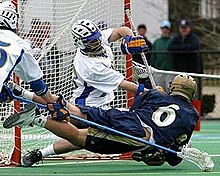
A player taking a "swoop shot"
The European Lacrosse Federation (ELF) was established in 1995 and held the first European Lacrosse Championships that year.[70] Originally an annual upshot, it is now held every 4 years, in between FIL'southward men's and women's championships. In 2004, 12 men'south and 6 women's teams played in the tournament, making information technology the largest international lacrosse event of the year. The final men's tournament was in 2016, when 24 countries participated. England won its ninth gold medal out of the x tournaments played. 2015 was the last women's tournament, when 17 teams participated in the Czechia. England won its 6th gilded medal, with Wales earning silver and Scotland statuary. These 3 countries from Great United kingdom of great britain and northern ireland have dominated the women's championships, earning all but three medals since the tournament began in 1996. In that location are currently 29 members of the ELF, they make up the majority of nations in the FIL.[71]
The Asia Pacific Lacrosse Marriage was founded in 2004 by Commonwealth of australia, Hong Kong, South korea and Japan.[72] It currently has 12 members and holds the Asia Pacific Championship for both men'southward and women'southward teams every two years.[73] [74]
Lacrosse was played in the World Games for the starting time time at the 2017 Globe Games held in Poland. Only women's teams took part in the competition. The United states won the gold medal defeating Canada in the finals.[75] Australia won the statuary medal match. The Haudenosaunee Nationals women's lacrosse team could not participate.[ citation needed ]
Lacrosse in the United States
College lacrosse
Men's college lacrosse
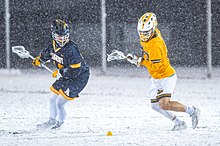
Collegiate lacrosse in the Us is played at the NCAA, NAIA and social club levels. There are currently 71 NCAA Division I men'south lacrosse teams, 93 Division II teams, and 236 Division III teams. 30-two schools participate at the NAIA level. 184 men's club teams compete in the Men's Collegiate Lacrosse Clan, including about universities and colleges exterior the northeastern United states of america. The National College Lacrosse League and Slap-up Lakes Lacrosse League are 2 other lower-sectionalisation social club leagues. In Canada, 14 teams from Ontario and Quebec play field lacrosse in the fall in the Canadian University Field Lacrosse Association.[76]
The starting time U. S. intercollegiate men'south lacrosse game was played on November 22, 1877 between New York University and Manhattan College.[77] An organizing body for the sport, the U. Due south. National Lacrosse Clan, was founded in 1879 and the commencement intercollegiate lacrosse tournament was held in 1881, with Harvard beating Princeton three–0 in the title game.[78] Annual postal service-season championships were awarded by a variety of early on lacrosse associations through the 1930s. From 1936 to 1972, the United States Intercollegiate Lacrosse Association awarded the Wingate Memorial Trophy to the best college lacrosse squad each year.[79]
The NCAA began sponsoring a men's lacrosse championship in 1971, when Cornell took the first title over Maryland, 12–six. Syracuse has 10 Division I titles, Johns Hopkins 9, and Princeton half-dozen.[lxxx] The NCAA national championship weekend tournament draws over 80,000 fans.[81]
Women'due south college lacrosse
There are currently 112 Division I women's lacrosse teams, 109 Division Two teams, and 282 Division III teams. In that location are 36 NAIA women's lacrosse teams. The NCAA started sponsoring a women's lacrosse championship in 1982. Maryland has traditionally dominated women's intercollegiate play, producing many head coaches and U.S. national team players. The Terrapins won seven consecutive NCAA championships from 1995 through 2001. Princeton'southward women'due south teams have made it to the final game seven times since 1993 and have won three NCAA titles, in 1993, 2002, and 2003. In contempo years, Northwestern has become a force, winning the national title from 2005 through 2009. Maryland ended Northwestern's streak by defeating the Wildcats in the 2010 last, however, Northwestern won the next ii titles in 2011 and 2012. Maryland once again claimed the national title in 2014, 2015, and 2017.[82]
The Women'south Collegiate Lacrosse Associates (WCLA) is a collection of over 260 college order teams that are organized by US Lacrosse. Teams are organized into 2 divisions and various leagues.[83]
Professional lacrosse
Major League Lacrosse
Major League Lacrosse (MLL) is a semi-professional field lacrosse league started in 2001 with 6 teams in the Northeastern U.s.. The league currently has nine teams in the Eastern United States and Denver playing a 14-game season from April to August. MLL rules are based on NCAA men's rules with several exceptions, such as a sixteen-thou 2-point line and a 60-second shot clock.[84]
MLL venues range from small-scale stadiums with nether 10,000 capacity to an NFL stadium in Denver that seats 76,000. Overall league average attendance is around 4,000 per game, but Denver has averaged around x,000 per game since its founding in 2006.[85] The rookie bacon is $vii,000 per season and most players make between $10,000 and $twenty,000 per season. Therefore, players accept other jobs, often not-lacrosse related, and travel to games on the weekends.[86]
The Chesapeake Bayhawks, who have played in the Annapolis–Baltimore–Washington, DC surface area since 2001, are the most successful franchise with v championships.[87]
National Lacrosse League
The National Lacrosse League (NLL) is a men's semi-professional box lacrosse league in Due north America. The NLL currently has 15 teams, ten in the United States and 5 in Canada. The eighteen-game regular season runs from December to April; games are always on the weekends. The champion is awarded the National Lacrosse League Cup in early on June.[88]
Games are played in water ice rinks with artificial turf covering the water ice. Venues range from NHL arenas seating xix,000 to smaller arenas with under 10,000 chapters. In 2017, average attendance ranged from three,200 per game in Vancouver to over 15,000 in Buffalo. Overall, the league averaged ix,500 people per game.[89]
With an average salary around $20,000 per flavour, players have regular jobs, mostly non-lacrosse related, and alive in different cities, flying into boondocks for games.[xc] Canadians and Native Americans make up over 90% of the players.[91]
The NLL started in 1987 every bit the Eagle Pro Box Lacrosse League. Teams in Philadelphia, New Jersey, Baltimore and Washington, DC, played a 6-game season. The league operated as the Major Indoor Lacrosse League from 1989 to 1997, when at that place were half dozen teams playing a x-game schedule. The current NLL name began in the 1998 flavor, which included the first Canadian team.[92]
The nigh successful franchises have been the Toronto Rock and the now-defunct Philadelphia Wings, each has won half-dozen championships.[92]
Premier Lacrosse League
In October 2018, former MLL actor Paul Rabil branched abroad from the MLL and created the Premier Lacrosse League. The PLL focuses on beingness a traveling lacrosse league that will bring the best players in the world to different cities in the United States.[93]
United Women'south Lacrosse League
The United Women'due south Lacrosse League (UWLX), a iv-team women's lacrosse league, was launched in 2016. The teams are the Baltimore Ride, Boston Storm, Long Island Sound and Philadelphia Force. Long Island won the showtime ii championships.[94]
Women's Professional Lacrosse League
The Women's Professional person Lacrosse League is a professional women's lacrosse league with 5 teams that started in 2018.[95]
Equipment
Stick
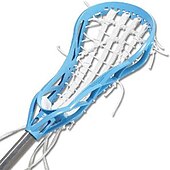
The lacrosse stick has two parts, the head and the shaft. At that place are three parts to the caput: the scoop, sidewall, and pocket. The scoop is the peak of the stick that affects picking up ground ball likewise as passing and shooting. The sidewall is the side of the head that affects the depth of the head and the stiffness. The pocket is the leather or nylon mesh attached to the sidewall and scoop. A wider pocket allows an easier fourth dimension catching assurance, but will also cause less ball control. A narrower pocket makes catching harder, but allows more ball retention and accuracy.[96]
Shafts are normally made of hollow metal. They are octagonal, instead of round, in lodge to provide a improve grip. Nigh are made of aluminum, titanium, scandium, or alloys, simply some shafts are fabricated from other materials, including woods, plastic, carbon fiber, or fiberglass.
Stick length, both shaft and head together, is governed by NCAA regulations, which require that men'south sticks be from 40 to 42 inches (100 to 110 cm) long for offensive players, 52 to 72 inches (130 to 180 cm) long for defensemen, and 40 to 72 inches (100 to 180 cm) long for goalies.[27]
Women's sticks must be an overall length of 35.five–43.25 inches (xc.2–109.nine cm). The caput must exist seven to nine inches wide and the top of the ball must remain above the side walls when dropped in the pocket. The goalkeeper's stick must be 35.5–48 inches (90–122 cm) long. The caput of the goalie'southward stick can up to 12 inches (30 cm) wide and the pocket may be mesh.[97]
Ball
The ball is made of solid rubber. It is typically white for men's lacrosse, or yellow for women'southward Lacrosse; but is likewise produced in a wide multifariousness of colors, such equally yellow, orange or lime green co-ordinate to the Men'due south Lacrosse Rules and Interpretations. In the college level the Lacrosse ball is orange.[98]
Men's field protective equipment
Men's field lacrosse protective equipment contains a pair of gloves, elbow pads, shoulder pads, helmet, mouthguard, and cleats. Pads differ in size and protection from player to player based on position, power, comfort and preference. For example, many set on players wear larger and more protective elbow pads to protect themselves from checks thrown at them while defenders typically wear smaller and less protective pads due to their smaller possibility of beingness checked and goalies usually wear no elbow pads due to the very limited opportunities of beingness checked. A goalkeeper must also wear a large protective breast pad to cover their tum and chest and a plastic neck guard that connects to the mentum of their helmet to protect them from shots hitting their windpipe. In addition, male person goalkeepers are required to wear a protective cup.[27]
Men's box protective equipment
Men's box players article of clothing more protective gear than field players due to the increased physical contact and more permissive checking rules. Cantankerous-checking in the dorsum is immune by the rules. Runners wearable larger and heavier elbow pads and stronger shoulder pads that extend down the dorsum of the histrion. Virtually players wear rib pads besides.[99] Box goalies wear equipment very similar to ice hockey goalies, the leg blockers are somewhat smaller, although the shoulder pads are bigger than ice hockey pads.[100]
Women's field protective equipment
Women'southward field players are not required to wear protective equipment too eyewear and a mouthguard. Eyegear is a metallic muzzle covering the eyes attached with a strap around the dorsum of the head. In contempo years, there has been word about allowing or requiring padded headgear to protect confronting concussions. Women goalies wear a helmet, gloves, and chest protector.[27]
See also
- Polocrosse, a version of lacrosse played on horseback
- Hurling, an ancient Gaelic squad sport played with sticks and a ball
- Indigenous North American stickball
References
- ^ Britannica Educational Publishing (2015). Lacrosse and Its Greatest Players. Britannica Educational Publishing. pp. 10–12. ISBN978-1-62275-593-vi.
- ^ Vennum, Thomas. American Indian Lacrosse: Footling Brother of War. (Smithsonian Institution, 1994) SBN 978-1560983026.
- ^ Liss, Howard. Lacrosse (Funk & Wagnalls, 1970) p. 13.
- ^ "The Native American Origins of Lacrosse".
- ^ Thomas Vennum (2008). American Indian Lacrosse: Lilliputian Brother of War. JHU Press. p. 232. ISBN978-0-8018-8764-two.
- ^ "FIL Rules of Men'southward Field Lacrosse, 2019-2020" (PDF). The Federation of International Lacrosse. 2018.
- ^ Francois Fortin (2000). Sports: The Consummate Visual Reference. Firefly Books. pp. 229–. ISBN978-1-55297-807-8.
- ^ Chris Hayhurst (2005). Lacrosse: Rules, Tips, Strategy, and Safety. The Rosen Publishing Group. pp. 23–31. ISBN978-1-4042-0183-5.
- ^ Stewart, Megan (October 10, 2013). "Through Lacrosse, Empowerment for First Nations". The Tyee.
- ^ a b c "Virtually World Lacrosse". World Lacrosse. Retrieved August seven, 2019.
- ^ Fisher, Donald M. (March xiv, 2002). Lacrosse: A History of the Game. JHU Press. ISBN9780801869389 . Retrieved December 2, 2016 – via Google Books.
- ^ "STX Blog - 7 Reasons Why Lacrosse Should exist an Olympic Sport". Retrieved December 2, 2016.
- ^ Nathan, Daniel A. (Baronial ane, 2016). Baltimore Sports: Stories from Charm City. Academy of Arkansas Press. ISBN9781682260050 . Retrieved December 2, 2016 – via Google Books.
- ^ "Lacrosse Programme" (PDF). Wsyacy.com . Retrieved November 28, 2016.
- ^ Pietramala, David G.; Grauer, Neil A. (May 17, 2006). Lacrosse: Technique and Tradition, The 2nd Edition of the Bob Scott Archetype. JHU Press. ISBN9780801883712 . Retrieved December ii, 2016 – via Google Books.
- ^ Liss, Howard (1970). Lacrosse. Funk & Wagnalls. p. 13.
- ^ Vennum, Thomas (2002). American Indian Lacrosse: Trivial Brother of State of war . Smithsonian Establishment. ISBN978-1560983026 – via Internet Annal. [ page needed ]
- ^ "Lacrosse History". STX. Archived from the original on May 24, 2007. Retrieved February 24, 2007.
- ^ Rock, Tom (November–December 2002). "More Than a Game". Lacrosse Magazine. The states Lacrosse. Archived from the original on August 22, 2007. Retrieved March 18, 2007.
- ^ "Lacrosse, the Creator'south game". Oneida Indian Nation . Retrieved September 9, 2018.
- ^ a b c Adamski, Barbara K. "Lacrosse". The Canadian Encyclopedia.
- ^ "Lacrosse: E-Lacrosse Lacrosse History, Links and Sources". E-lacrosse.com. Archived from the original on Oct 8, 1999. Retrieved February 25, 2011.
- ^ "An account of the remarkable occurrences in the life and travels of Colonel James Smith". Lexington: John Bradford. 1799. pp. 77–78. OCLC 1038782222. Retrieved November viii, 2017 – via Net Archive.
- ^ Claydon, Jane (ed.). "Origin & History". Federation of International Lacrosse. Retrieved November 15, 2017.
- ^ "History". Bryn Mawr Schoolhouse. Retrieved Dec 2, 2017.
- ^ "2016 Participation Survey" (PDF). US Lacrosse.
- ^ a b c d "Equipment for Boys' and Men's Lacrosse". U.s.a. Lacrosse.
- ^ "Field Diagrams". U.s. Lacrosse.
- ^ a b c d "Men's Rules". US Lacrosse.
- ^ "Getting started: Beginners Lacrosse 101". Lacrosse.com.
- ^ "Boys' Rules". US Lacrosse.
- ^ a b c d east "Box Lax 101". National Lacrosse League. Retrieved November 15, 2017.
- ^ a b Fisher, Donald K. (2002). Lacrosse: A History of the Game . Johns Hopkins University Press. ISBN0-8018-6938-ii.
- ^ "Box Lacrosse Equipment Guideline". Zone4Laxx.com. Archived from the original on November 21, 2008. Retrieved Oct 28, 2008.
- ^ The Rules of Indoor Lacrosse / Box Lacrosse - EXPLAINED! on YouTube
- ^ a b "National Lacrosse League 2017 Official Rules" (PDF). National Lacrosse League. Retrieved November 15, 2017.
- ^ Vennum, Thomas (2002). American Indian Lacrosse: Little Brother of War . Smithsonian Institution. p. 287. ISBN978-1560983026.
- ^ "2015-2018 Women'south Official Rules" (PDF). Federation of International Lacrosse. Retrieved November fifteen, 2017.
- ^ "Girls lacrosse: FHSAA hopes helmets will cut downwardly on concussions". Naples Daily News . Retrieved January 18, 2019.
- ^ Lyndsey Munoz (Apr twenty, 2016). "LACROSSE 101: DRAWS VS. FACEOFFS". Winners Lacrosse. Retrieved Baronial 14, 2019.
- ^ "History of Lacrosse at St Leonards". STLeonards-Fife.org. Archived from the original on May vi, 2008. Retrieved May 1, 2008.
- ^ "Hall of Fame to induct first woman Sinclair enters posthumously". baltimoresun.com. February 6, 1993. Retrieved Baronial 14, 2019.
- ^ "2019 Youth Girls' Rulebook" (PDF). United states of america Lacrosse. Retrieved August 14, 2019.
- ^ "2016 Women'southward Rulebook" (PDF). US Lacrosse. Retrieved November 15, 2017.
- ^ "Competitions". FIIC. Retrieved Nov 12, 2017.
- ^ "Intercrosse – What has that got to do with lacrosse?". Captain Lax. Retrieved Baronial 14, 2019.
- ^ "World Cup / Earth Championship". Fédération Internationale d'Inter-Crosse. Archived from the original on November 12, 2017. Retrieved November xiv, 2017.
- ^ Krome, Paul (June 1, 2016). "Soft Stick, Big Impact". Usa Lacrosse.
- ^ "Physical Teaching Curriculum". U.s.a. Lacrosse.
- ^ "ASPAC Lacrosse Tournament". ASPAC. Retrieved August 14, 2019.
- ^ "A short history of lacrosse in Europe". European Lacrosse Federation. Retrieved August 14, 2019.
- ^ Mackay, Duncan (May 5, 2019). "Lacrosse launches new name and logo at SportAccord Meridian as continues Olympic push button". Inside the Games . Retrieved May 5, 2019.
- ^ "FIL Members – Federation of International Lacrosse". January 2019.
- ^ "Tape Field for 2014 FIL Globe Championship" (Press release). Usa Lacrosse. Retrieved Nov 14, 2017.
- ^ "World Championship History". US Lacrosse. Retrieved November 14, 2017.
- ^ "Women's Lacrosse World Cup Playing Schedule" (PDF). England Lacrosse. Retrieved November 14, 2017.
- ^ Ditota, Donna (September 27, 2015). "Canada dashes Iroquois' dream, continues domination in Globe Indoor Lacrosse Championship". Syracuse.com . Retrieved November 13, 2017.
- ^ "Lacrosse: From Creator'southward Game to Modern Sport". The Canadian Encyclopedia . Retrieved November 14, 2017.
- ^ "2013 Women's Earth Cup Championship Bracket Final". Globe Lacrosse News and Data. July xx, 2013. Retrieved Baronial fourteen, 2019.
- ^ "1904 Winnipeg Shamrocks". The Manitoba Sports Hall of Fame & Museum. Retrieved November 14, 2017.
- ^ Brownell, Susan (2008). The 1904 Anthropology Days and Olympic Games. Academy of Nebraska Press. p. 229. ISBN978-0-8032-1098-i . Retrieved April half dozen, 2009.
- ^ Owen, David (April 25, 2008). "David Owen on the 1908 Olympic celebration". Within the Games. Archived from the original on May ii, 2008.
- ^ "Amsterdam Games Olympic Official Report part two" (PDF). LA84 Foundation. 1928. pp. 907–911. Archived from the original (PDF) on Oct 27, 2016. Retrieved November 15, 2017.
- ^ "Official Written report of the Xth Olympiade Committee in Los Angeles 1932" (PDF). LA84 Foundation. 1932. pp. 763–766. Archived from the original (PDF) on September 18, 2018. Retrieved November 8, 2017.
- ^ "Lacrosse on the Olympic Stage". Lacrosse Magazine. US Lacrosse. September–Oct 2004. Archived from the original on Oct 23, 2007. Retrieved November 13, 2008.
- ^ "Official Written report of the 1948 London Olympics" (PDF). LA84 Foundation. pp. 532–533.
- ^ "International Lacrosse History". US Lacrosse. Archived from the original on September 20, 2008. Retrieved November 13, 2008.
- ^ "FIL Men's Lacrosse World Loving cup 2018". World Lacrosse.
- ^ "Earth Lacrosse Welcomes Ghana As Its Newest Member-National Governing Body On Mean solar day 1 Of General Associates". Earth Lacrosse. Baronial 12, 2019. Retrieved August fourteen, 2019.
- ^ "A short history of lacrosse in Europe". European Lacrosse Federation. Retrieved November 14, 2017.
- ^ "ELF Country Membership". European Lacrosse Federation. Retrieved November 14, 2017.
- ^ "History of the Asia Pacific Lacrosse Marriage". Asia Pacific Lacrosse Union. January thirty, 2015. Retrieved November fourteen, 2017.
- ^ "Member Nations". Asia Pacific Lacrosse Spousal relationship. December 2, 2014. Retrieved November 14, 2017.
- ^ "ASPAC Championship History". Asia Pacific Lacrosse Union. March 23, 2015. Retrieved Nov 14, 2017.
- ^ Vatz, David (Baronial xi, 2017). "The 2017 World Games: An Important Step to the Highest Stage". Inside Lacrosse.
- ^ Canadian University Field Lacrosse Clan Accessed December xiv, 2018.
- ^ "The History of Lacrosse: The Higher Game". Sunset Sports . Retrieved October 21, 2018.
- ^ Pietramala, David K.; Grauer, Neil A.; Scott, Bob (2006). Lacrosse: Technique and Tradition . Johns Hopkins University Press. ISBN0-8018-8371-7.
- ^ "National Champions". USILA. Retrieved August fourteen, 2019.
- ^ "Title History". NCAA. Retrieved November 14, 2017.
- ^ Lee, Edward (June 3, 2016). "Omnipresence increased for NCAA men's lacrosse championships in Philadelphia". Baltimore Sun . Retrieved November 14, 2017.
- ^ "Championship History". NCAA. Retrieved November xiv, 2017.
- ^ "College". USLacrosse. Retrieved August 14, 2019.
- ^ "About MLL". Major League Lacrosse. Archived from the original on January 29, 2014. Retrieved Jan 31, 2014.
- ^ "2017 League Attendance". Major League Lacrosse.
- ^ Garcia, Ahiza (September 28, 2015). "The pro athletes with full-time day jobs". CNN Money.
- ^ "Bayhawks History". Chesapeake Bayhawks. May 21, 2016. Retrieved August 14, 2019.
- ^ "NATIONAL LACROSSE LEAGUE UNVEILS ITS NEW CHAMPIONSHIP TROPHY". National Lacrosse League. April 30, 2018. Retrieved August 14, 2019.
- ^ "League Omnipresence". National Lacrosse League.
- ^ Flaherty, Ryan (March 18, 2016). "Professional sports life more than just lacrosse for Blitz players". Global News.
- ^ Postage, Stephen (May 13, 2015). "Box lacrosse participation in the US is limited from grass roots to NLL level; tin can ALL assist growth?". Inside Lacrosse.
- ^ a b "History". National Lacrosse League.
- ^ "Premier Lacrosse League". PremierLacrosseLeague.
- ^ DaSilva, Matt (Baronial two, 2017). "Long Island Audio Echo every bit UWLX Champions". The states Lacrosse Magazine . Retrieved November xiv, 2017.
- ^ Berri, David (June 4, 2018). "The Women's Professional Lacrosse League Takes Off". Forbes . Retrieved June 9, 2018.
- ^ Chris Reid (December i, 2014). "LACROSSE HEADS 101". lacrosse.com.
- ^ "Equipment for Girls' and Women'south Lacrosse". U.s. Lacrosse.
- ^ "2015 and 2016 Men'south Lacrosse Rules and Interpretations" (PDF). NCAA Publications: 2015 and 2016 Men's Lacrosse Rules and Interpretations. October 2014. Retrieved May 3, 2017.
- ^ "Box Lacrosse Equipment - Role player Guidelines". Mississauga Tomahawks Lacrosse. Ontario Lacrosse Association. Retrieved Baronial 14, 2019.
- ^ "Box Lacrosse Equipment - Goalie Guidelines". Mississauga Tomahawks Lacrosse. Ontario Lacrosse Association. Retrieved August 14, 2019.
Further reading
- Beers, William George (1869). Lacrosse: The National Game of Canada. Dawson Brothers. ISBN9780665056826.
- Culin, Stewart (1975). Games of the North American Indians. Courier Dover. ISBN0-486-23125-nine.
- Downey, Allan. The creator's game: Lacrosse, identity, and Indigenous nationhood (UBC Press, 2018).
- Fink, Noah; Gaskill, Melissa (2006). Lacrosse: A Guide for Parents and Players. Mansion Grove House. ISBN9781932421071.
- Fisher, Donald M. Lacrosse: A history of the game (JHU Press, 2002).
- Jiloty, John; Keegan, Mike; Sacco, Matthew F. (2003). Lacrosse: Due north America's Game. Towson, Doc: Carpenter. ISBN0-9759834-0-7.
- Pietramala, David G.; Grauer, Neil A.; Scott, Bob (2006). Lacrosse: Technique and Tradition . Johns Hopkins University Press. ISBN0-8018-8371-seven.
- Stoikos, Alex. A Journalistic Overview of Lacrosse in the Western Globe" Academia Messages, (2021) Article 1591. https://doi.org/10.20935/AL1591
- Tucker, Janine; Yakutchik, Maryalice (2008). Women'due south Lacrosse. Johns Hopkins University Press & U.Due south. Larcrosse. ISBN978-0-8018-8846-5.
- Wiser, Melissa C. "Lacrosse History, a History of I Sport or Two? A Comparative Analysis of Men's Lacrosse and Women'south Lacrosse in the Usa." International Journal of the History of Sport 31.13 (2014): 1656-1676.
- Yeager, John M. (2006). Our Game: The Graphic symbol and Culture of Lacrosse . Dude. ISBN1-887943-99-4.
External links
![]()
Wikimedia Commons has media related to Lacrosse.
![]()
Wikisource has original text related to this article:
- U.s. Lacrosse – The national governing body for lacrosse in the United States.
Source: https://en.wikipedia.org/wiki/Lacrosse

0 Response to "Game Stick With A Net"
Post a Comment